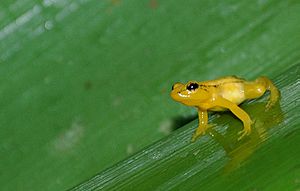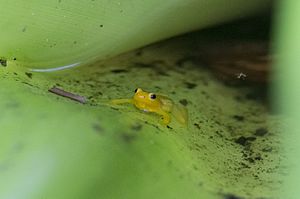Anomaloglossus beebei facts for kids
Quick facts for kids Anomaloglossus beebei |
|
|---|---|
 |
|
| Conservation status | |
| Scientific classification | |
| Synonyms | |
|
Colostethus beebei (Noble, 1923) |
The Anomaloglossus beebei is a small frog also known as the Beebe's rocket frog or golden rocket frog. It belongs to the Aromobatidae family. This special frog lives only in Guyana, a country in South America. You can find it in the Kaieteur National Park.
This frog mostly lives on a huge plant called the Brocchinia micrantha. This plant is a type of bromeliad. The frog uses the plant's leaves to lay its eggs and raise its tadpoles. Male frogs protect these special spots. Female golden rocket frogs are a bright golden color. Males are usually a dull tan with some brown spots. Male frogs also take care of their young. Females often choose males with longer calls.
Contents
About the Golden Rocket Frog
The golden rocket frog has bumpy skin. Its first finger is shorter than its second. It also has stripes on its back. These features help scientists tell it apart from other frogs.
Female frogs are much brighter than males. They are a shiny golden color. Males are a dull tan. They have brown spots on their backs, sides, and legs. These brown spots become darker when the male is calling. Only adult females develop an orange color.
Male frogs make different calls. Females are not known to call. Males can be identified by their unique calls. There are different ideas about whether this frog is poisonous or not.
Where They Live
The golden rocket frog lives only in Guyana, in South America. You can find it specifically on the Kaieteur plateau. This area is inside the Kaieteur National Park. The frogs live at about 450 meters (1,476 feet) above sea level.
The Brocchinia micrantha bromeliad plant grows in Kaieteur National Park. The frogs depend on this plant for their home and for breeding. The plant's leaves collect water from rain or mist. These small pools of water are called phytotelmata. The frogs use these pools to lay eggs and raise tadpoles. The water in these pools is often a bit acidic.
The Kaieteur Falls also affects where these frogs live. Some scientists think the mist from the falls helps the frogs.
Protecting Them
The IUCN Red List of Threatened Species lists this frog as vulnerable. This means it could become endangered. The frog lives in only one small area, Kaieteur National Park. It occupies less than 20 square kilometers (about 7.7 square miles) within the park.
Clever Behavior
This frog was once called Colostethus beebei. Now its name is Anomaloglossus beebei.
These frogs are very good at recognizing their neighbors. This is called the "dear enemy effect." It means they react differently to a frog they know versus a stranger. They are more aggressive towards strangers. This behavior is also seen in some birds and other frogs.
Scientists did an experiment with male golden rocket frogs. They played calls from neighbors and from unknown frogs. The male frogs moved closer to the unknown calls. They also made aggressive calls. This shows they can tell friends from strangers.
What They Eat
When golden rocket frog tadpoles are in the plant's water pools, they eat different things. They might eat fallen leaves and tiny living things. Tadpoles also graze on algae and catch small prey in the water.
Sometimes, female frogs lay eggs that are not fertilized. These eggs are for the tadpoles to eat. This gives the tadpoles extra food. It has been seen that larger tadpoles can sometimes eat smaller ones. However, this is not very common.
Life Cycle
Golden rocket frogs breed all year. But they breed the most from June to August. These are the rainiest months. More rain means the plant's water pools are full. Breeding happens right on the plant.
Male frogs protect their water pool territory. This allows the female to lay her eggs there. Before laying eggs, the male and female perform a courtship dance. Scientists think these frogs might stay together as a pair for a long time.
This frog species shows biparental care. This means both parents help raise the young. Males can care for eggs from many females. This means they can have more offspring.
Once a female chooses a male's territory, she stays in the water pool. She lays about 4 to 6 eggs near the water line. Soon after, the male moves the tadpoles to another water pool. If it's dry, males squirt fluid on the eggs to keep them moist.
Female frogs can also take care of the tadpoles if the male is not there. They can even move the tadpoles themselves. Mothers can also lay unfertilized eggs for their young to eat.
Mating Calls
Male golden rocket frogs make different calls for different reasons. They have three types of calls: courtship calls, calls for territory fights, and calls to attract females.
When a male is in his territory, he makes long-range calls to attract females. These calls are high-pitched and short. They have three or four quick pulses. Once a female comes closer, the male uses a different call. This close-range call convinces the female to mate.
Males call for several hours each day. Some scientists believe females prefer males with faster calls. A fast call might mean the male is healthy and strong. Other scientists think females look for longer calls. A longer call might mean the male is a better parent.
Females that respond to calls are led to different water pools by the male. Sometimes, females might leave a male and look at other spots. These frogs use more complex sounds for mating and courtship than for fighting.
Different Calls
A male's calls are not linked to his size or weight. The calls might help different frog species recognize each other. For example, the Kaiei's rocket frog is similar to the golden rocket frog. Its call is like the golden rocket frog's advertisement call. But the Kaiei's rocket frog's call has a lower sound and slower pulses.
The three calls of the Anomaloglossus beebei frog are:
- Advertisement calls: These are loud and have longer pulses.
- Courtship calls: These have lower sounds.
- Aggressive calls: These have more pulses and longer pauses between calls. Sometimes, they start with one or two pulses before the main call.
Male Frogs Interacting
Male frogs can tell the difference between neighbors of their own species and frogs from other species. This is helpful. Males might fight over territory. These fights can involve wrestling and chasing. They can last for several days. Being able to tell other frogs apart helps males decide how aggressive to be.
Female Frogs Interacting
Female frogs can sometimes be aggressive towards other females and even males. However, their aggression is limited. They do not defend the whole bromeliad plant like the males do.
Who Eats Them
Predators of golden rocket frog eggs and tadpoles live in the bromeliad plants. These include grapsid crabs, dragonfly larvae, and spiders. These predators are more common in water pools with lower leaf angles. Grapsid crabs also eat adult frogs.
Adult frogs do not fight the crabs. Instead, they try to avoid being eaten.
See also
 In Spanish: Anomaloglossus beebei para niños
In Spanish: Anomaloglossus beebei para niños



